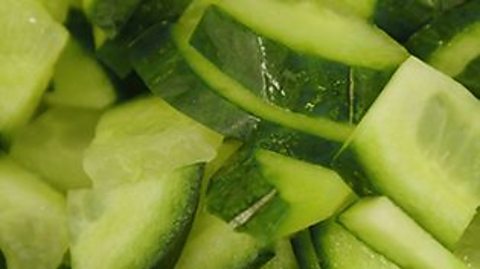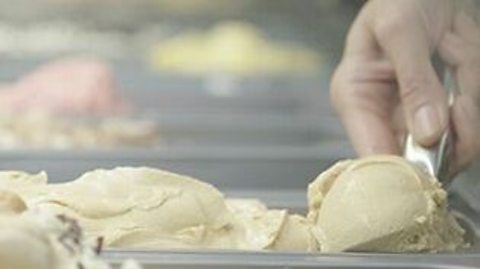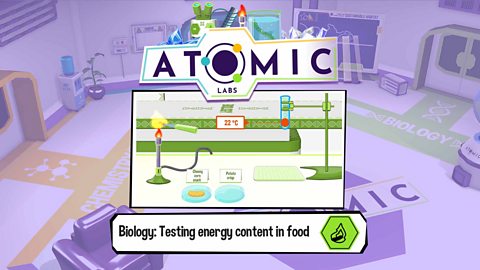Key points
- Food is a store of energy, transferred from the food to the consumer.
- 'Food energy' is measured in joules (J) or kilojoules (kJ.)
- Food types (groups) have different amounts of energy.
- Different people need different amounts of energy.
Game - food energy
Play an Atomic Labs experiment to explore the energy content of different foods.
You can also play the full game
What is food energy?
- Food is a store of chemical energy, which is transferred to the consumerAn organism, usually an animal or fungus, which obtains its energy as food from other organisms. when eaten.
- Stored energy from the food is transferred to the animal that eats it (the consumer).
- Each individual requires a specific amount of food, depending on their energy requirements.
- This energy from plants and animals keeps the consumer alive and allows it to carry out its activities.
Video - sports nutritionist
Watch to find out more about food energy and different food groups.
Learn about food energy from a sports nutritionist
Food energy is the energy that we get from eating food. And different types of foods give us different levels of energy.
My name is Mayur Ranchordas, and I'm a sports nutritionist. We help professional athletes and elite athletes eat better to perform better and recover better.
So when we talk about food, not all foods are the same. So some foods are what we call carbohydrates, like rice, pasta, potato, cereal, and they give us energy. Then you've got protein, meat and fish, they help in repairing muscle. Then you have fats, and fats are very energy-dense, so things like butter, avocados, and they give us a lot of energy. And depending on what you're doing, what training you're doing, what sport you compete in, the demand changes.
If I was a marathon runner, I would be covering 80-100 miles a week, and that means I have a much greater reliance on fats and carbohydrates. As a sprinter, you might use carbohydrate only because you need to access that energy very quickly.
The most surprising food that you would not think gives you energy is actually milk. So milk contains protein, it contains carbohydrate, it also contains electrolytes like sodium, potassium that are great for hydration. Milk is a bit of a superfood really.
If you're interested in sport and if you're interested in food and you're interested in how they both interact with each other, then sports nutritionist is definitely the job for you.
Sports nutritionists guide athletes in deciding what to eat to perform at their best. They need a good knowledge of how much energy is stored in different foods, as well as understanding how quickly the energy is released to the body.
How much energy do you need?
Energy is measured in joules (J) or kilojoules (kJ). An older unit for measuring food energy is the kilocalorie, often just called calories. One calorie is 4.2 J.
Different animals need different amounts of energy. An elephant needs around 200,000 kJ every day, and a cat about 800 kJ.
The amount of energy a human needs depends on many things, including their age and what they are doing. An elite athlete training regularly would need much more energy than the average person. During pregnancy more energy is required to help the unborn baby grow.
Typically, a 13-year-old girl would need 9,000 kJ every day and a 13-year-old boy would need around 10,000 kJ every day.
Different food groups
Each one of the five food groups is important. All food contains energy.
- Fruit and vegetables contain vitamins to keep the body working and help the immune system and fibre which helps digestion.
- Proteins build healthy muscles and allow the body to grow and repair.
- Fats and oils act as an energy store.
- Carbohydrates keep energy levels up.
- Dairy contains calcium for strong teeth and bones.
Video - jelly baby experiment
How much energy is in a jelly baby?
All living things are in an energy race. We have to keep getting enough food to fuel our bodies. But not quite this much!
The food industry uses the word calories to describe how much energy is contained in food. But scientists prefer to use the word joules - let's see how many joules are in this jelly baby.
Our body uses food like a steam train uses coal. As we break down our food, it releases the energy our body needs. This is respiration, and it happens in our cells. We can look at how this works in the lab, by reacting our food with potassium chlorate, a powerful oxidising agent. Now according to the packet, one jelly baby contains 90 kilojoules. So, let’s see what 90 kilojoules of energy looks like when we release it in 10 seconds.
So, let's give it a go…
90,000 joules released in 10 seconds.
A reaction similar to this is going on inside our own bodies lot slower and a lot less intense. The cells in our bodies release the energy from the jelly baby by combining it with oxygen that we breathe. This is aerobic respiration. Aerobic respiration is a chemical reaction. If you've ever wondered how we calculate how many calories there is in food, it's probably because someone somewhere has been burning it and measuring the joules of energy released.
If every jelly baby has 90 kilojoules, this means there's a lot of energy in this trolley, which is a good thing considering we need about 11,000 kilojoules a day.
Everyone needs some knowledge of food energy, so that they can eat sensible amounts of the foods they need to stay healthy. Regularly consuming food containing more energy than you need can lead to becoming overweight and then obesityMedical term for being very overweight, owing to the excessive accumulation of body fat..
Test your knowledge
Order the activities
Quiz - Food Energy
Play the Atomic Labs game! gamePlay the Atomic Labs game!
Try out practical experiments in this KS3 science game.

More on Nutrition, digestion and excretion
Find out more by working through a topic
- count4 of 15

- count5 of 15

- count6 of 15

- count7 of 15

